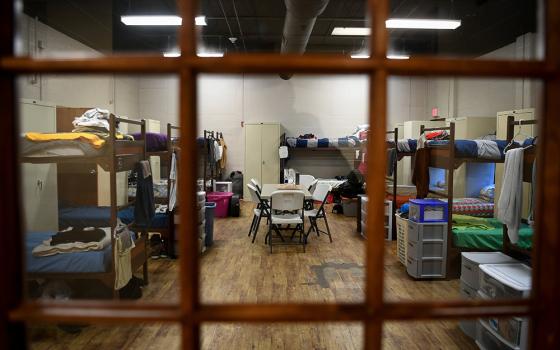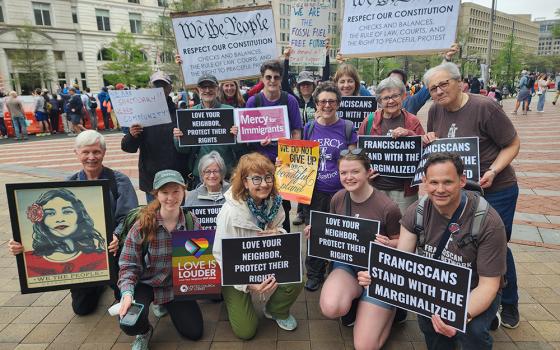
VIEWPOINT
Former Secretary of State George Shultz, at a gathering at Stanford University in California, called on religious leaders to envision a world free of nuclear weapons. Shultz, a distinguished fellow at the Hoover Institution at Stanford, joined a dozen religious leaders and policymakers at the May event.
Nuclear weapon issues, as presented at the gathering, can be divided roughly into four categories: changes in the international climate as they affect nuclear weapons; disarmament successes to date; new and growing nuclear weapons threats; and, finally, possible initiatives to be taken.
Participants presented a rough history of the arms race, saying that from World War II until the end of the Cold War in 1989, the world lived under the threat of mutual assured destruction (with its acronym, MAD). This was the period during which the United States and Soviet Union aimed large numbers of nuclear-equipped missiles at each other, and these missiles were kept on hair-trigger alert, posing risks of catastrophic proportions. These risks were mitigated only by the fact that each of the protagonists operated in a developed nation supported by sophisticated technical equipment, and each nation was constantly evaluating the other to avoid a false calculation or accidental attack.
By contrast, participants at the Stanford gathering painted a very different global situation today. With the Cold War over and the Soviet Union dissolved, Russia is seen as more ally than enemy. Further, the end of the Cold War, participants concurred, has undermined the moral argument plausibly supporting a deterrent system based on the threat of mutual assured destruction. Today, with nuclear threats coming from rogue groups and not nation states, Cold War deterrence has questionable value.
The picture painted during the meeting was one of progress made on the disarmament front in recent decades. One hundred eighty-four nations have signed the 1968 Nuclear Nonproliferation Treaty, including more than 40 that were nuclear-weapons capable. The United States and Russia have worked to reduce nuclear arsenals. The number of deployed weapons has fallen from 70,000 to 20,000. In recent months Russia and the United States have signed the New START treaty. Thirty-five nations have signed a Comprehensive Test Ban Treaty; unfortunately, the United States is not one of them. Also on the gains front, 47 nations recently attended a Washington conference on control of fissile materials from nuclear weapons. President Obama has called nuclear proliferation and nuclear terrorism “a threat that rises above all others in urgency.”
What conference participants heard in discussions was that while the Cold War’s nuclear-related threats have subsided, new threats have arisen, chief among these the threat of these weapons getting into the hands of terrorists.
Terrorists, as one conference paper put it, have “no return address,” and thus cannot be deterred by a threat of nuclear retaliation.
Meanwhile, the nuclear weapons club has expanded, with nations such North Korea within it that seem to have less to lose in a nuclear attack, and whose behavior often seems unpredictable.
The conference participants heard people speak of the growing risks of proliferation of nuclear weapons technology. Both North Korea and Pakistan, for example, have passed on technology to other nations, including Iran.
 Adding to pessimism, as one person noted, is the fact that the nine nuclear-possessing nations have been slow to rid themselves of these weapons, thus losing grip on the moral argument that “have-not” nations should refrain from entering the nuclear club.
Adding to pessimism, as one person noted, is the fact that the nine nuclear-possessing nations have been slow to rid themselves of these weapons, thus losing grip on the moral argument that “have-not” nations should refrain from entering the nuclear club.
Noted during the gathering was a growing interest (prior to the disaster at the Fukushima Daichii plant in Japan in March) in nuclear electric power among some nations. Such production plants would bring with them the potential for more nuclear enrichment facilities and the need to store fissile materials. This would in turn multiply potential opportunities for terrorists to find a way to obtain such materials.
As one participant at the conference said, “We’ve been lucky, lucky, lucky.” So far.
Finally, participants at the meeting mentioned that at a time of major budget deficits the U.S. will be increasingly forced to look again at the huge expenditures on maintaining nuclear weapons and developing new ones, weapons that are meant to deter when deterrence is no longer an effective strategy.
One participant called the spending on these weapons a “bait-and-switch” scheme. Citizens are persuaded to approve and pay for hugely expensive nuclear arsenals whose main justification is deterrence. Yet the very fact of maintaining these weapons erodes nonproliferation efforts and poses even a greater threat that terrorists will one day obtain those weapons.
Participants agreed that there is a great urgency to move to “zero” nuclear weapons.
The participants recognized that there were real hurdles to overcome, not least of which is what one person referred to as the “straightjacket” of deterrence thinking. Old habits and patterns are hard to break; people look on deterrence as having “worked,” and hence are loath to give it up. They reflect less on the fact that history has moved on and that deterrence is no longer effective against today’s major threats.
Moreover, one participant said, MAD is now “off the radar” and not a “front-burner” issue.
Adding to the proliferation problem, some nations, such as Israel, continue to see nuclear weapons as necessary for their security, participants said. Other governments -- for example, Japan -- see America’s nuclear umbrella as providing protection against regional antagonists. Others with such weapons see them as providing protection against invasion by the United States, a lesson some drew from the fact that the U.S. invaded Iraq, but has not invaded North Korea or Iran.
Reference was made during the gathering to an article by Graham Allison in Foreign Affairs in which the author compares the current nuclear weapons situation to the financial crisis in 2008 when conventional wisdom still saw the global economic system as stable and robust. Allison ends his article by saying that we failed to heed credible warnings of an eroding financial system. He warns that if the world similarly waits for a collapse in global nonproliferation schemes, “there is no feasible bailout.”
The hurdles are real, but the threats are catastrophic and need to be addressed promptly, members of the gathering concluded.
The effort, a key participant said, has to be global. It cannot be left only to the United States and Russia. We will need a new international “architecture” of control and security. The objective, this participant said, must be to allow nations to disarm, to move to zero nuclear weapons, and still be comfortable and feel safe. That would involve verification, intrusive fact-finding, inspections and other steps, all the way to the use of force against a country trying to breach the disarmament agreement.
A new architecture has to begin with confidence-building measures, the building of trust, including small, measurable, mutually agreed-upon steps. One example cited was the U.S.-Russia decrease in nuclear weapons.
One notion discussed was that of “virtual deterrence,” an idea built on the fact that while you can dismantle all weapons, you cannot eliminate the knowledge of how to build them. The argument goes that in a disarmament regime, nations would be deterred from building weapons anew by the knowledge that if they began and were detected, other nations would have the incentive also to build and the arms race would begin anew.
As the meeting broke up, Shultz distributed copies of a DVD, “Nuclear Tipping Point.” (Copies are available at www.nucleartippingpoint.org.) The DVD features four respected former U.S. government officials now engaged in the cause of nuclear disarmament -- Shultz, former Secretary of State Henry Kissinger, former Secretary of Defense William Perry and former Sen. Sam Nunn.
Sidney Drell, a co-convener of the meeting, is the cofounder of the Center for International Security and Cooperation at the Freeman Spogli Institute for International Studies at Stanford. Among the attendees were Bishop Robert McElroy of San Francisco; Jesuit Fr. J. Bryan Hehir, professor at the Kennedy School of Government at Harvard University; and William Swing, retired bishop of Northern California and founder and president of United Religions Initiative.
Also participating were the Rev. Tyler Wigg-Stevenson, chairman of the Global Task Force on Nuclear Weapons for the World Evangelical Alliance; Scotty McLennan, chaplain of Stanford University; the Rev. Katherine Lehman; and David Holloway, a Stanford political science professor.
[John Weiser, former general counsel of Bechtel Group Inc., is chair of the President’s Council of United Religions Initiative.]


